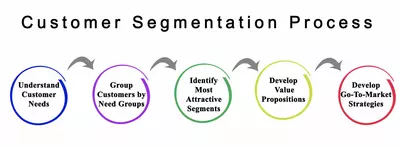Market Segmentation Fuels Your Business Strategy
Market segmentation guide to accelerating your business growth in the year ahead
You might also like…
Content Creators and Social Media Influencers in the Digital Economy
What does the state of influencer marketing look like in 2024? Discover how content creators and influencers are enmeshed in the digital economy....
Qualitative Market Research: The Complete 2023 Guide
Qualitative market research helps collect key non-numerical data for analysis. Learn the qualitative research benefits, methods, and more. Inside...
The Importance of Demographic Survey Questions in Surveys
Learn why a foundational component of surveys is demographic questions, which enable you to understand the nature and characteristics of your respondents...
Introduction to Market Segmentation

Not so long ago, our prospects for doing business were mostly limited to those within reasonable proximity to our geographic area. The law of the land was “small business,” and options for the consumer were relatively few.
Today’s business world could not look more different. International trade happens in an instant with a tap of the glass on a smartphone screen. Someone can live in San Diego and have a business that primarily serves people on the East Coast.
In a world where the potential target market for a product or service is the entire world, how does one get the most out of their marketing efforts?
Enter: Market segmentation…

What is market segmentation?
Market segmentation is essentially the breaking down of a target market into manageable chunks. Taking a broad group of potential customers and identifying commonalities between them allows companies to craft messaging that speaks to consumers directly rather than throwing out the widest possible net and hoping to catch the right consumers.
Without market segmentation, it would be impossible even to know who the right consumers were. Imagine trying to sell someone who lives in an apartment on lawn care service or marketing steering wheel covers to people who only ride motorcycles. The fact that we know intuitively that these things make no sense is evidence of segmentation’s power.
By conducting this process effectively, we can get more specific by conducting one or multiple iterations of analysis. We can identify subtle similarities and differences between groups who tend to be more or less likely to have a desire or need for our products and services.

The examples above may be a bit simplistic, but they get the point across. What’s more—they illustrate two different types of segmentation, of which there are many. In the next section, we’ll look at the five most common types across the myriad of industries.
What are the 5 types of market segmentation?
Although the exact number can vary based on who you ask, for the purpose of this guide, we’ll say there are five main types of market segmentation from which to classify your target population:
- Geographic
- Demographic
- Firmographic
- Psychographic
- Behavioral

Other, less common types of segmentation can often be just as useful but are arguably somewhat derivative in essence. So we’ll go through, one-by-one, each of the five main types to help you gain a clearer understanding of what they all mean.
Geographic Segmentation
Even if you know nothing about statistics or marketing, this one is probably the easiest to understand. Geographic segmentation determines where in the world, the people most likely to be served by the product or service in question reside. Most people in Colorado, for example, have no use for surf gear. Likewise, people who live in the tropics have little need for heavy winter clothing. Geography plays such a critical role in commerce that products that don’t make sense for a particular area are often difficult, if not impossible, to buy locally.
Demographic Segmentation
One of the most popular and commonly-used types, demographic segmentation looks at statistical data about individuals or groups of people. This may include things like age, race, sex, marital status, level of education, and occupation, among others. The specific combination of these factors varies and may include one, all, or none of these. Because this type deals with individuals or groups, it is most useful in business-to-consumer selling situations.
Firmographic Segmentation
While demographics are most useful for business-to-consumer environments, firmographic segmentation deals strictly with organizations and is therefore only useful for business-to-business marketing. This type of segmentation classifies companies based on attributes such as industry, number of employees, or annual revenue.
Psychographic Segmentation
Psychographic segmentation distinguishes audiences based on personality traits, values, beliefs, and goals. You’ll notice that, unlike the preceding three, this type of segmentation is more abstract and therefore more advanced. While you can easily identify things like demographics and geography, making good use of psychographics requires high-quality research. The upside is that, if done properly, it can result in much more personal marketing communication.
Behavioral Segmentation
Lastly, behavioral segmentation requires knowledge of a customer’s actions such as spending habits, brand loyalty, and propensities toward leaving reviews—positive or negative. Like psychographic segmentation, this one requires some data in order to be really effective, but much of this can be collected relatively easily. While not as simple as demographic, geographic, or firmographic segmentation, some may find this type to be more approachable than psychographic segmentation.
But let’s not get too far into the details; instead, let’s have a look at how you might use segmentation to your advantage.

What are some key benefits that market segmentation provides?
Market segmentation provides critical insight into who your target audience is and what you can do for them. While this alone should be enough to justify the practice, there are several key benefits that make using market segmentation worthwhile.
First, market segmentation helps focus resources in areas that have the highest chance of success. Remember the surf shop in Colorado? The reason that there are few, if any, is because market segmentation suggests that marketing surf gear to people who live at least a half day’s drive from the nearest beach is a waste of time and money.
Another benefit that market segmentation offers is that it helps the marketer craft specific communication for people within their target audience. By collecting information about each of their email subscribers, for example, marketers can speak directly (or nearly so) to them instead of sending out generic mass-market advertisements.
What’s more, it’s easier for companies to stay consistent with their brand messaging. When you know what your audience will and will not respond to, it’s more difficult for a new and exciting (yet ineffective) idea to throw you off course.
Every company, from the bakery down your street to major corporations like Apple, can benefit from understanding and implementing segmentation into their marketing. That said, it’s the brands that are already household names that help us understand this practice most clearly, so let’s look at a few examples
.
What are some market segmentation examples?
There are countless ways to look at how market segmentation might be used, but the easiest method is looking at examples. In doing so, we can illustrate how certain segmentations might be critical in one instance and irrelevant in another.
As a first example, let’s look at Whole Foods…

When people think of Whole Foods, different things probably come to mind based on their relationships with the brand.
Those who prioritize health-conscious food choices probably think of the store in a positive light. Knowing that many of the products found there cost more than options elsewhere is likely not a deterrent; they don’t mind paying a premium because they consider these products to be a higher-quality choice.
On the other hand, some people either don’t care about or can’t reasonably afford foodstuffs marked organic, non-GMO, grass-fed and other labels that seem to drive up the price of otherwise affordable goods. To them, Whole Foods may seem overpriced and exploitative.
There’s probably some truth in both perspectives, but the point is that Whole Foods doesn’t care about trying to bring in customers who don’t fit the profile of the first example group. They expect their customers to have more disposable income (demographics), place a higher value on “health foods” (psychographics), and not mind paying more for their groceries (behavior).
Notice that although demographics are important as a category, certain aspects of demographics don’t matter as much here, such as age or gender.
For another example, let’s look at McDonald’s…
McDonald’s boasts the most popular burger globally while, arguably, from a historical perspective, they have not used the highest quality ingredients.
But until more recently, when they tested the plant-based protein burgers, the fact is they didn’t even talk about their ingredients because the people they were targeting didn’t place a high value in this area.
Still, what McDonald’s talks about is their food being hot, convenient, and satisfying. They also don’t bother much with regional items, preferring to allow national standards to dictate any variation in menu choices.
They are an establishment that serves working individuals and their families, and, as such, they change with the common man (and woman). Whereas their target audience once prioritized speed and convenience over all else, the average consumer now enjoys having a variety of options, uses technology for entertainment, and wants to have a bit of an upscale feel thanks to the Starbucks of the world.
Thus, the timers have vanished from the drive-thru windows, the PlayPlace has all but disappeared, and we now have McCafé for when the coffee needs a little something extra.
As one can plainly see from these examples, not only is there no end to the number of combinations of market segments that can be applied to an organization’s communication and offerings but using the same segments can lead to significant changes as time goes on.
The Segmentation Process

How can you implement market segmentation in your business?
By now, you should have a thorough understanding of what market segmentation is, what the major segments are, and what it looks like in practice. Now it’s time to take all of that and apply it to your business.
But before we jump into the how-to’s, we should make one thing clear: Market segmentation is probably not going to be the beginning and end of your marketing strategy, especially not at first. Like every other marketing effort, it will require testing and refinement in order to maximize its effectiveness.
With that in mind, the first step to implementing market segmentation is doing your market analysis. You should already have a general idea of what it is that you want to do, whether you’re selling physical goods, a software-as-a-service product, or a service like web development or landscaping.
Whatever the case may be, you’ll need to gather a lot of data using various data collection tools like:
Market Surveys can profile your customers as well as look at prospects proactively.
Data Mining of an existing company and publicly available data on customer and prospect transactional and behavioral data for quantitative data analysis.
Web forms can also be a great way of doing this because it allows you to provide value to the people who visit your site or your profile page in exchange for basic information. This should be enough info to be useful, but not so much that it makes the visitor want to click away. This balance can be found by testing.

Next, you’ll need to analyze the data you’ve collected and sort it into segments. There are analysts and marketing experts who can help you do this and, if you have the budget for it, this is a great route to go. Experts know what trends to look for in your data, and they have plenty of experience finding it.
If hiring an expert isn’t in your budget, though, don’t worry. You can work with what you have by manually sorting through data and checking to be sure that you can reach the segments you identify. When sorting, you should make sure you are selecting things that are likely to be stable, profitable, and relatively homogenous.
- Measurable: Take steps to ensure that product purchases are tied to your segmentations. It’s important to have the data available to calculate or estimate how much your segment will spend on products and services.
- Accessible: Defining and describing your customer segments is essential and steps should be taken to ensure segments are accessible. Accessible not only from a demographic or behavioral plus economic point of view but also with the ability to be accessed practically from communications or a distributions point of view.
- Substantial: Defining and describing your customer segments is a great idea, but only if they are realistically substantial from a market potential and economically practical standpoint. It would be wonderful to find enthusiasts of your high-end surfboards but if they can’t afford them then they are not a substantial segment from a financial point of view.
- Actionable: Ensure your marketing segmentation informs your segments for marketing niche marketing communications. Its important segments describe customer personas that are different and also durable in they are stable and not flash audiences.
The final step in this introductory process is—you guessed it—testing. Now that you’ve got your segments identified, it’s time to come up with a plan to put them to work.
This plan should look different based on what resources and platforms you have available, but generally, you should be looking to confirm your hypothesis that the segments you’ve identified are likely to respond positively to your marketing messages.
Don’t be afraid to try new ideas and respond to feedback from colleagues, peers, and most importantly, your target market. Once you find something that works, stick with it, but be sure to keep an eye out for any changes time may bring—you don’t want to lose the market you worked so hard to find!
Follow
OvationMR

Jim Whaley
Author
Jim Whaley is a business leader, market research expert, and writer. He posts frequently on The Standard Ovation and other industry blogs.
OvationMR is a global provider of first-party data for those seeking solutions that require information for informed business decisions.
OvationMR is a leader in delivering insights and reliable results across a variety of industry sectors around the globe consistently for market research professionals and management consultants.

Need help with your project?
We are ready to offer you:

